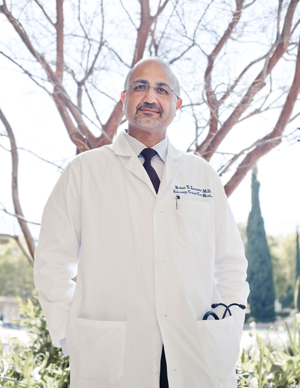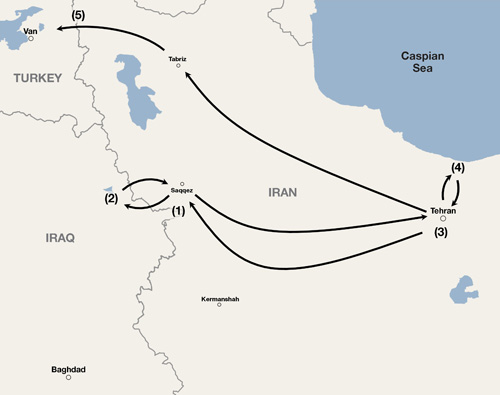August 25, 2010 - By Bruce Goldman
Roham Zamanian’s calm in treating a fatal disease can be traced back to his escape from Iran as a young boy
Eleven years old and all alone in a strange country, Roham Zamanian awaited his destiny.
The year was 1983, and what had appeared to be the final leg of a journey to freedom had suddenly spun out of control. The smuggler who’d guided Zamanian, his mother and his 3-year-old sister across the border from Iran had enemies who’d tipped off authorities. When the Turkish border patrol intercepted the escapees’ caravan, Zamanian’s mule, loaded with three or four suitcases, had spooked and taken off with him still perilously perched on top.
What had become of his mother and sister, he didn’t know. It would be days before he saw another human being.
Zamanian describes his two-year ordeal to escape Iran after the revolution and how the experience has shaped the doctor he is today. Length: 6 min
The year before, his politically radioactive father had sped from Tehran to Los Angeles in 22 days. For Zamanian it was going to take longer: two years of nighttime travel, missed connections, bogus visas and stolen passports, hiding in plain sight from the mullahs — in a mullah’s house — and a glimpse of his future through the eyes of a physician he met on a rocky road to the West.
Looking back on that trip from the safety of almost three decades’ passage, Zamanian, now a physician himself, didn’t recall being frightened. “It was just surreal,” he said.
As director of the adult pulmonary-hypertension service at the Vera Moulton Wall Center for Pulmonary Vascular Disease at Stanford University Medical Center, Zamanian guides patients along another rocky road, one that begins with a diagnosis of pulmonary hypertension, a condition characterized by high blood pressure in the lungs and right side of the heart. Left untreated, fewer than half of all patients with this disease are still alive three years after diagnosis. Even with treatment, only three out of five live for five years.
“The people who develop this disease are often young,” said Zamanian, who is also an assistant professor of pulmonary and critical care medicine. “They have their lives stolen from them.” Coping with a diagnosis of PH requires courage, discipline and willpower. Zamanian can relate.
* * *
It was the fall of 1982. In almost any other era, Roham Zamanian’s parents would have been respected citizens of Iran. His grandmother and her sisters had been among the very first female schoolteachers in Iran. His mother was a schoolteacher, too. His father was a telecommunications engineer.
But the Islamic revolution that in 1979 overthrew Shah Mohammad Reza Pahlavi had set modernity back on its heels and thrown political fortunes into flux. To make matters worse, the Revolutionary Guards of Khomeini’s Islamic Republic found out that his father had helped set up a pirate telecommunications operation for young Roham’s maternal uncle, a socialist political leader who was covertly beaming anti-regime broadcasts out of his hiding place in Iranian Kurdistan. They showed up at the family’s home in the middle of the night, arrested Zamanian’s father and incarcerated him for several months in Tehran’s infamous Evin prison. The day before his scheduled execution, he was accidentally released. He fled immediately to Turkey, then Spain and ultimately to political asylum in the United States.

As Roham Zamanian and his family tried to flee Iran when he was 10 years old, one of the other escapees he met was a neurosurgeon whose empathy inspired Zamanian to seek a career in medicine.
Zamanian’s mother was left in a tight spot, given her association with both her brother and her husband. She was certain the Revolutionary Guards would eventually be paying her family another not-so-friendly visit. Within a few months of her husband’s hasty departure from Iran, she decided she and her children would have to make a run for it. So, one day, she picked 10-year-old Roham up at school in Tehran and, with his 2-year-old baby sister in tow, embarked on what would become an epic journey: an escape from Iran, fighting fate all the way.
On the first leg, the mother and her two children found refuge — after a long bus ride and trek — in a remote village in Kurdistan where the uncle and his organization were based. A month later, they formed a caravan with several other Iraq-bound escapees, traveling at nighttime from village to village on horseback along winding, wintry trails through a mountainous, oak-tree-dotted landscape split by ravines. Young Zamanian rode alone, astride a luggage-lugging mule.
Among the strangers in this group was an Iranian neurosurgeon who freely offered medical assistance to the residents of each town the caravan stopped at. “He didn’t ask for payment or barter arrangements, he would just provide his services,” said Zamanian. “And he made a real impact on these people who were saving our lives.”
The doctor was equipped with neither devices nor prescription pads. “Healing wasn’t done with a medication, or a stethoscope, or a pill,” Zamanian said. “It was just taking a minute to talk to them, to listen to human suffering. Listening is, by itself, healing. That’s what I understood.”
Zamanian was impressed with the combined power of medicine and empathy to ease human suffering. Abandoning earlier fantasies of becoming a pilot, he resolved to be a doctor when he grew up.
“I don’t think I ever thought of being anything else after that.”
The caravan crossed the border to a town on the Iraqi side, hoping for friendly treatment from Saddam Hussein’s regime, which was then engaged in a savage war with the new Iranian government. But their hopes of safe passage were crushed, Zamanian said. “After a few weeks in limbo, we were turned back and ordered to leave the country immediately."
* * *
Now what? Zamanian and his mom and sister returned to Tehran. Arriving in the dead of night, they knocked on the door of his maternal aunt’s house. “Go away, don’t come in,” whispered a voice behind the door. “They’re watching us.” Zamanian’s aunt wasn’t home, the voice told them. She was in prison, being tortured. Next, the trio headed to Zamanian’s paternal grandparents’ house, where they learned that Zamanian’s maternal grandmother (who was in her 70s) had been repeatedly detained, too. Staying in Tehran was not a safe option.
They did stay in the city for close to a month, moving from one nervous neighbor’s house to another’s until the fear of exposure finally became overwhelming. A relative drove them to a village an hour north of Tehran. “My sister and I hid under a blanket in the back seat,” Zamanian recalled. On their arrival in the town, his ever-resourceful mom encountered the local mullah’s wife — a total stranger — and, in a bold stroke, beseeched her for shelter. “My husband is dead, a martyr of the Iran/Iraq war,” she cried. “We need a place to stay.” The unsuspecting couple took them in, providing another month’s refuge in a place the authorities would never think to look.
Another plan took shape, this time intended only for the threesome. Selling what remained of her immediate family’s possessions, Zamanian’s mother entrusted the proceeds and their passports to a new smuggler. “He took off with them,” Zamanian said. Fate was a formidable foe.
But fate hadn’t met Zamanian’s mother. Through political connections, she managed to sign on to another group escape attempt featuring some of the same people they’d traveled with the first time around. This time, their destination was Turkey.
* * *
They left again. After first being put in a car and driven to the city of Tabriz in Iran’s far northwest corner, they were smuggled toward the Turkish border in yet another horse-and-mule caravan.
“In what had become a bit of a routine, I was riding on a mule, with a whole lot of luggage,” said Zamanian. The entourage proceeded westward from village to village through a valley surrounded by rolling hills, finally crossing into Turkey’s Kurdish eastern sector.
Evidently the smuggler had enemies, who tipped off the border patrol. Out of nowhere, several official Jeeps swept down from all sides and intercepted the caravan. Zamanian’s mom, who was on a horse with his little sister in the front of the caravan, was arrested. Others fled in every direction.
Zamanian’s mule bolted and ran away with Zamanian and several suitcases on top. Mule and rider didn’t stop until they arrived at a rock formation out of sight of the border patrol. The now-11-year-old Zamanian took shelter there. It was nighttime, and the moon lit up the valley. That night he saw his first shooting stars. “To this day,” he says, “when I see a moonlit sky at night I’m immediately taken back to this place and time.”
He slept. When he awoke, the mule was gone. It was muddy and wet.
After four or five days on his own, drinking water from a stream and eating what he can now describe only as “vegetation,” he bumped into some other stragglers from his atomized party who, like him, were by now ready to turn themselves in.
The Turkish authorities turned out to be relatively friendly (and amenable to financial “encouragement” by allies of the caravan’s guide). They kept the family in loose detention for about eight months, while Zamanian’s mother hatched her next plan to reunite them with his father. She eventually acquired forged passports and fake Canadian visas, and they flew from Istanbul to Amsterdam, planning to board a connecting flight to Montreal. From Canada they intended to slip across the border into the United States.
But in the Amsterdam airport, customs officials became suspicious of their documents, and some dicey moments followed. Luckily, Zamanian’s activist-uncle’s organization had a contact who was married to a Dutch woman. The couple intervened on their behalf, got them temporary asylum and took them in. About six months later, they were granted political asylum in the United States. They landed in Los Angeles on Sept. 24, 1984, and were reunited with Zamanian’s dad.
Zamanian wound up in Irvine, Calif., and stayed put there through his medical residency. “I didn’t want to move again,” he said. That changed when he accepted Stanford’s pulmonary hypertension fellowship in 2005.
But the Iranian neurosurgeon Zamanian had met during his trip left an indelible impression. Struck by the physician’s compassion, listening skills and attentiveness, Zamanian vowed to emulate him. “I’m here only due to people’s openness, from villagers in Kurdistan to urbanites in Holland,” he said. “I try to give as much as I can, as a way of paying society back.”
He has also learned how to wait. “If my patients are late, they’re late,” he said.

1. In their effort to escape from Iran to the United States, Roham Zamanian and his mother and sister fled Tehran for the safety of remote villages in Kurdistan. 2. After crossing the border into Iraq, they were held in a small, makeshift military town for a few weeks before the authorities forced them to return to Iran. 3. They arrived back in Tehran in the middle of the night and quickly realized it was too risky for them to stay there. After brief stays in numerous houses (mostly their friends), 4. they hid out for several months, not revealing their true identities in a small village north of Tehran while his mother hatched a new plan. 5. They then travelled to Tabriz, where they were then smuggled across the Turkish border, but still faced more hurdles to their effort to reunite with his father in California.
About Stanford Medicine
Stanford Medicine is an integrated academic health system comprising the Stanford School of Medicine and adult and pediatric health care delivery systems. Together, they harness the full potential of biomedicine through collaborative research, education and clinical care for patients. For more information, please visit med.stanford.edu.